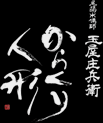In the Muromachi period, simple mechanical dolls were introduced at shrines and temples as entertainment for pious followers. Later in the Azuchi-Momoyama period, the prototypes of Zashiki Karakuri dolls appeared. The doll mechanisms became more elaborate, and those from the upper levels of society, such as the Imperial court and the samurai class, developed an interest in the dolls. Some of these deluxe dolls, called Daimyo Dōgu (samurai tools) incorporated simple mechanical parts such as levers, springs, and pulleys. The dolls called Gosho Ningyō (Imperial Palace Dolls) are one example of this type of doll.
When Oda Nobunaga invited Tokugawa Ieyasu to Azuchi Castle, he offered him a gold and silver Karakuri doll which functioned as a sake platter. In another well-known account, Toyotomi Hideyoshi sat his son Hideyori on his knees, and the two played with a Karakuri doll which spun around when coins were inserted into it (Rōjin Zatsuwa).
During the Edo period, Zashiki Karakuri dolls such as tea serving dolls (Chahakobi Ningyō) and magician dolls (Shinatama Ningyō) became more common, spreading to the households of daimyo, court nobles, and wealthy merchants. The famous courtesan Yoshino Tayu (1606-1643) is also said to have owned a crab-shaped Karakuri doll which served sake, which she considered on of her most treasured possessions (Takizawa Bakin, Chōsakudōissekiwa).
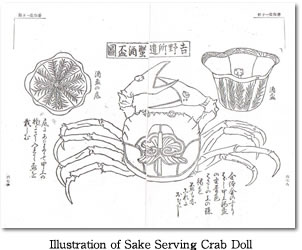
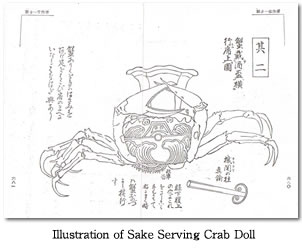
The Takeda Karakuri Theater's first public performance took place in 1662 at Osaka's Dōtonbori (Settsumeishizue, 1798 and Karakuri Kinmō Kagamikusa, 1730 - see the Karakuri Kinmō Kagamikusa heading in the reference section).
Takeda Ōmi is said to have come up with the idea for his theater during a trip to the Asakusa district of Edo (present-day Tokyo). He saw children there playing with sand, which gave him the idea to create dolls propelled by the same mechanism used in hourglasses. In 1658 he created what he called Karakuri dolls (which he describe using the now arcane characters 唐操偶人) and gave them to the Imperial court, leading to his appointment as a government official in 1660. He opened his Karakuri theater in 1662. Records show that he held performances in Nagoya on several occasions.
In contrast to Zashiki Karakuri dolls, Shibai Karakuri dolls (dolls used in theater) were manipulated backstage by puppeteers by way of strings and levers. Popular Karakuri doll stunts included launching blow darts, climbing stairs, writing characters, transforming into mythical creatures, launching arrows, and moving pillows.
The Takeda Karakuri Theater performed in Edo for the first time in 1741, then came back to the capital in 1757 for a second, highly popular performance. The next year, a collection of illustrations of Karakuri dolls entitled Dai Karakuri Ezuku-shi (大からくり絵尽) was published in Edo.
To the delight of the Japanese people, the Takeda theater continued performances across Japan, spanning four generations and a period of one hundred years.
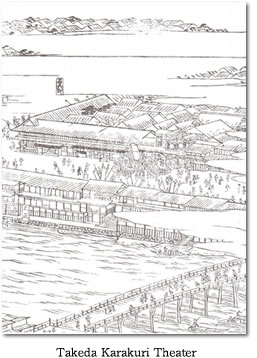
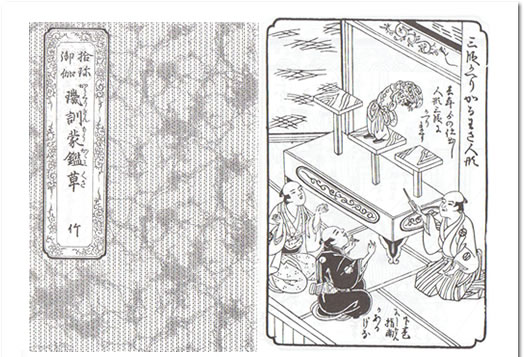
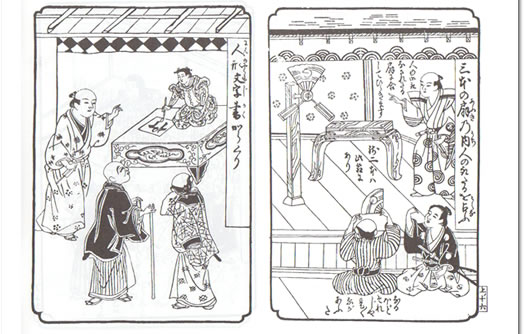


As Takeda Karakuri theater relied on skilled performers to bring the dolls to life, the question of performer skill came to play an increasingly important role in the theater, leading to the invention of Bunraku puppet theater in Osaka. San’ninzukai, a form of Bunraku puppet theater in which three puppeteers are employed to animate a single puppet, soon gained popularity among the general populace with its tales of domestic drama.
“In Edo, outdoor performances of Kabuki familiarized the public with theater performances. For the spectacle-loving inhabitants of Edo, the movements of the dolls were considered cute, but in the long run they were probably viewed as little more than wooden puppets. The mechanically complex Karakuri dolls used in the Dai Karakuri shows were probably more to their liking. Takeda Karakuri dolls used in Kabuki performances such as Kaidan no Uchikaeshi and Butsudan Kaeshi left a lasting impression on the citizens of Edo” (Takanashi Seima).













